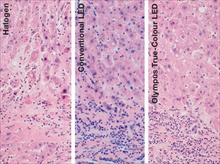Members Login

Channels
Special Offers & Promotions
Don
 Olympus provides its versatile, powerful BX3 clinical
microscope systems for analysis and disease diagnosis in pathology and
cytology. The systems take advantage of Olympus's new true colour LED
illumination technology and built in Light Intensity Manager (LIM) to create
images with accurately rendered colours. Histological and cytological stains
appear exactly the same under the true colour LED as they do under daylight
filtered halogen, facilitating a seamless transition for labs adopting the new,
more efficient LED technology. True colour LEDs offer longer lifetimes,
constant colour temperature at all voltages and reduced power consumption when
compared to traditional halogen bulbs. In addition, the LIM improves user
workflow and maximises consistency by automatically modulating light intensity
when working with different magnifications. Such advantages make the BX3
systems with true colour LED illumination the logical choice for comfortable
and efficient clinical microscopy.
Olympus provides its versatile, powerful BX3 clinical
microscope systems for analysis and disease diagnosis in pathology and
cytology. The systems take advantage of Olympus's new true colour LED
illumination technology and built in Light Intensity Manager (LIM) to create
images with accurately rendered colours. Histological and cytological stains
appear exactly the same under the true colour LED as they do under daylight
filtered halogen, facilitating a seamless transition for labs adopting the new,
more efficient LED technology. True colour LEDs offer longer lifetimes,
constant colour temperature at all voltages and reduced power consumption when
compared to traditional halogen bulbs. In addition, the LIM improves user
workflow and maximises consistency by automatically modulating light intensity
when working with different magnifications. Such advantages make the BX3
systems with true colour LED illumination the logical choice for comfortable
and efficient clinical microscopy.Insightful analysis in pathology and cytology hinges upon the years of experience provided by histological experts, developed using traditional halogen bulbs in combination with daylight filters. LEDs provide clear energy saving benefits but until now have not generated the level of colour reproduction obtained using halogen approaches. The Olympus true colour LED approach resolves this dilemma by utilising the most advanced mixed-matrix brightfield LED technology currently available to provide a colour rendering index very similar to that of halogen illumination. Stains such as Haematoxylin & Eosin and Papanicolaou look the same when using the Olympus LED as when using halogen light sources, while similar colours can be easily differentiated. These factors maximise the accuracy and reliability of diagnosis using the Olympus true colour LED illuminator.
With a large number of clinical samples to screen, the optimisation of user workflow can significantly improve the efficiency of pathological analysis. For this reason, the Olympus true colour illumination system with LIM automatically modulates light intensity when changing objective lenses. This means that consistent illumination is maintained without the need for manual adjustment, saving a significant amount of time, while simplifying and improving the screening process. Automation is achieved using sensors mounted in the nosepiece that detect the objective lens in use and manipulate the LED intensity according to user defined preferences.
The flexible Olympus BX3 clinical microscopy systems with true colour LED illumination and LIM have been specifically developed to meet the needs of clinical microscopy, ensuring reliable diagnosis while maximising workflow efficiency.
For more information visit www.microscopy.olympus.eu
Media Partners


